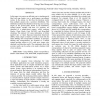Free Online Productivity Tools
i2Speak
i2Symbol
i2OCR
iTex2Img
iWeb2Print
iWeb2Shot
i2Type
iPdf2Split
iPdf2Merge
i2Bopomofo
i2Arabic
i2Style
i2Image
i2PDF
iLatex2Rtf
Sci2ools
ICMCS
2009
IEEE
2009
IEEE
Moving targets labeling and correspondence over multi-camera surveillance system based on Markov network
In this paper, we propose an efficient way to simultaneously label and map targets over a multi-camera surveillance system. In the system, we first fuse the detection results from multiple cameras into a posterior distribution. This distribution indicates the likelihood of having some moving targets on the ground plane. Based on the distribution, isolated targets, together with their 3-D positions, are identified in a sample-based manner, which combines Markov Chain Monte Carlo (MCMC), and Mean-Shift clustering. The induced 3-D scene information is further inputted into a 3-layer Bayesian hierarchical framework (BHF), which adopts a Markov network to deal with the object labeling and correspondence problems. In principle, labeling and correspondence are regarded as a unified optimal problem subject to 3-D scene prior, image color similarity, and detection results. The experiments show that accurate results can be gotten even under situations with severe occlusion.
| Added | 19 Feb 2011 |
| Updated | 19 Feb 2011 |
| Type | Journal |
| Year | 2009 |
| Where | ICMCS |
| Authors | Chingchun Huang, Sheng-Jyh Wang |
Comments (0)

